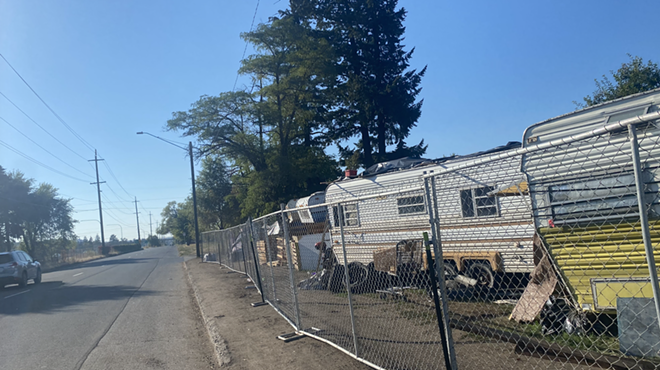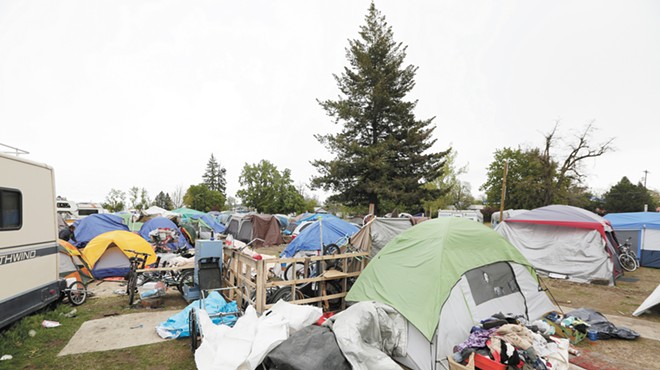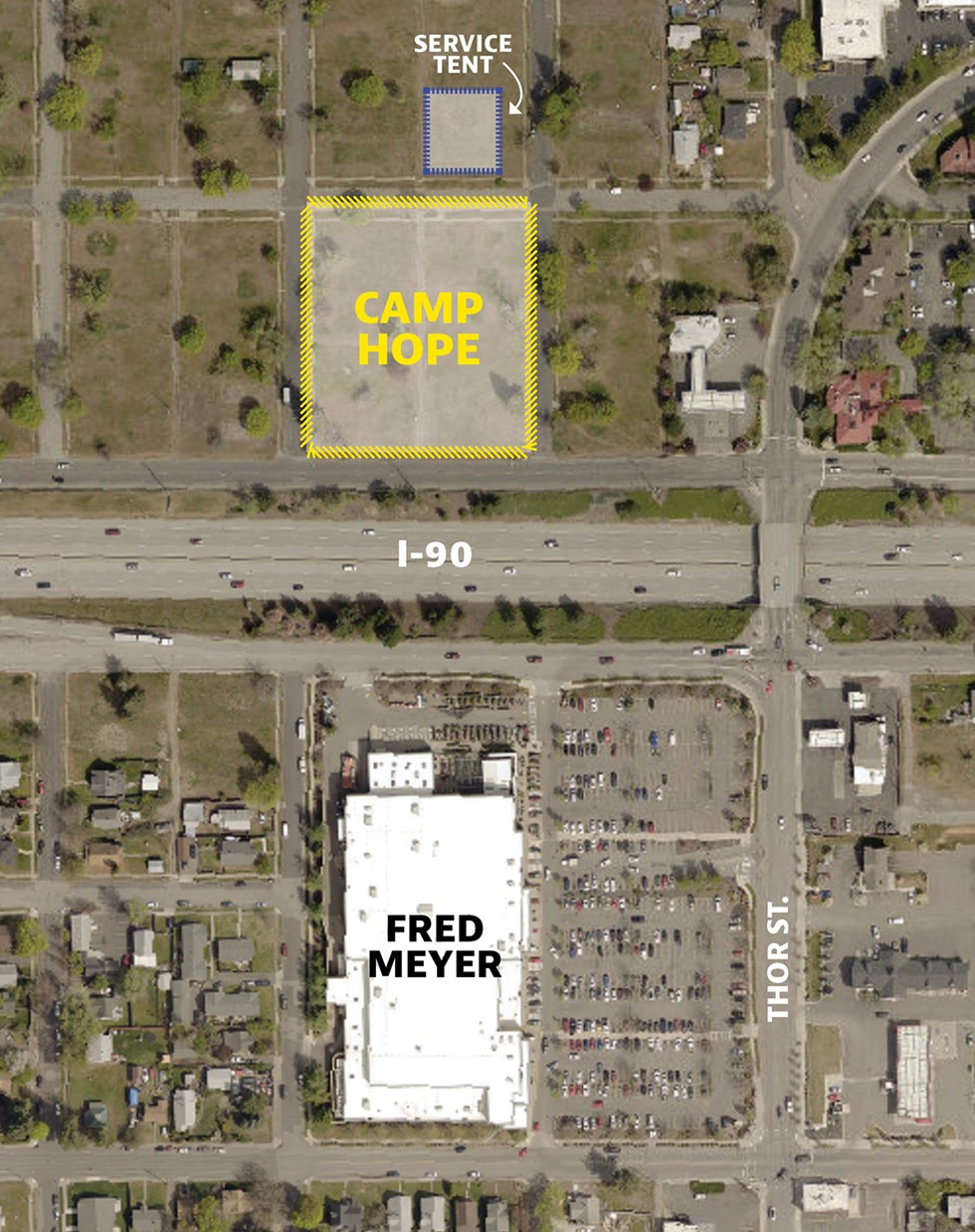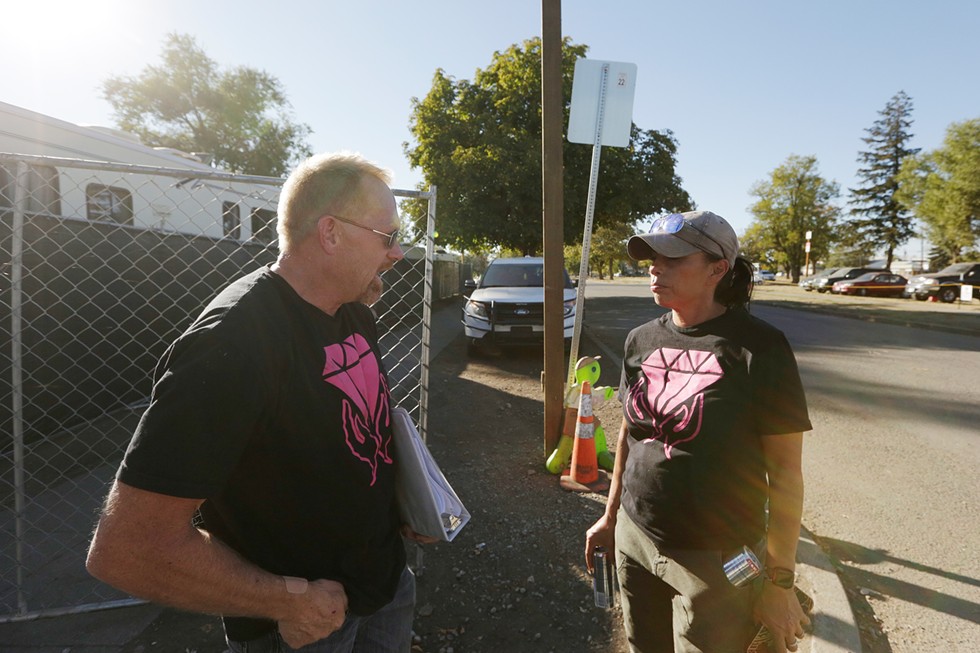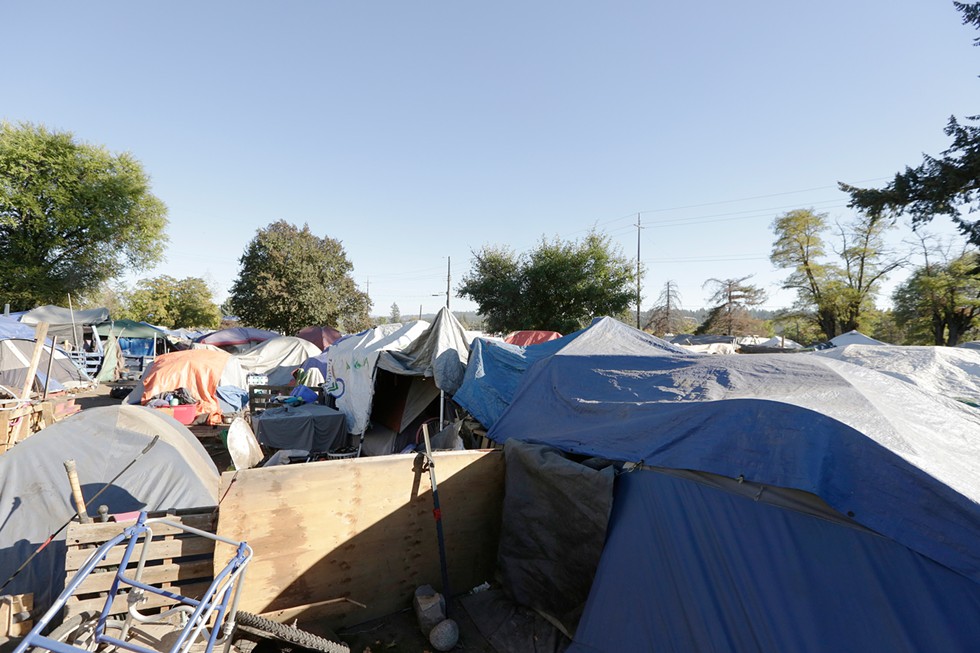
Two things set Camp Hope apart from other encampments in Washington: its size and the politics.
The East Central encampment is huge. There were close to 700 people living there during the camp's peak this summer. The total population is closer to 450 now, but that's still a staggering number of people squeezed onto a single city block. In July, the camp was added to Wikipedia's list of notable tent cities in the United States. The camp is the largest in Washington and appears to be one of the biggest unsanctioned encampments in the country.
"This is just an unprecedented number of people," says Tedd Kelleher, managing director of the Housing Assistance Unit at the state Department of Commerce. "I haven't been able to find other instances like this."
The level of political bickering and tension surrounding the camp is also unique. Homelessness is always a contentious issue, and it's not uncommon for state and local leaders to clash over the best approach for managing encampments, Kelleher says. But in Spokane, months of fiery letters, leaks, dueling news conferences and lawsuit threats have cranked the conflict to a breaking point.
"There's definitely some unique level of tension in Spokane right now," Kelleher adds.
Camp Hope sits within Spokane city limits, but on land owned by the state. That jurisdictional overlap has led to months of back and forth, and to two divergent, contradictory plans that will determine the future of the people living there.
The only thing the parties seem to agree on is that Camp Hope can't last forever.
The city, county and local law enforcement want the camp gone soon — ideally by the end of the month. They associate the camp with a rise in crime in the neighborhood and say local businesses and neighbors have suffered long enough. In late October, they declared a state of emergency and announced a plan that would see campers moved into the recently opened Trent Resource and Assistance Center and other shelter options available in Spokane. Spokane County Sheriff Ozzie Knezovich, who along with the Spokane mayor, police chief and Spokane County commissioners is leading the charge to sweep the camp, has given Nov. 15 as a target date for disbanding the camp — forcing campers who don't accept shelter referrals to leave.
On Monday, city spokesperson Brian Coddington said the target date is tied to the city's nuisance abatement order, which is still in the administrative process and has yet to go to the courts. Nov. 15 isn't necessarily a hard and fast deadline, he said, adding that the city still has an expectation for the camp to be cleared sooner rather than later.
"I can't speculate as to what's going to happen between now and the 15th," Coddington said.
The state says they want to see the camp gone as well, but only once the residents have been placed in better housing or shelter that matches their needs. They say offers of congregate shelter referrals do little to improve the situation for campers and that the camp can't be cleared until every camper has access to better, desirable housing options. Spokane doesn't have enough of that type of housing and shelter, and it's unclear how long it will take to stand it up. Much to the frustration of the city and some local businesses, the state hasn't given a firm estimate for how long that might take.
IT STARTED AS A PROTEST
Advocates trace the roots of Camp Hope to the region's housing affordability crisis, decades of austerity and the defunding of social programs across the country.
"This isn't a short-term problem," says Meagan Vincello, program director for the Empire Health Foundation, as she walks through the camp. "This is 60 years of how our society views social services."
As the number of people living unhoused in Spokane has risen, shelter beds and transitional housing options have struggled to keep up. In 2018, a few dozen tents popped up outside Spokane City Hall to protest the city's lack of action in the face of the growing crisis. They called themselves Camp Hope. The city swept the tents after a few weeks, despite opposition from activists.
A few years later, in December 2021, the tents were back, once more in protest of the city's lack of shelter and housing. After the city pledged to clear the tents, the campers moved that same month to the empty lot on Freya Street and Second Avenue in Spokane's East Central neighborhood. The lot is owned by the Washington State Department of Transportation — a fact that becomes crucial later.
Houses once sat on the vacant land, but they were razed over the past two decades to make room for the north-south freeway. It's a low-income neighborhood, already marginalized by the construction of I-90 in the 1960s, which cut the neighborhood in half.
Since its inception on WSDOT land, Camp Hope has been managed by Jewels Helping Hands, a nonprofit that has also been involved in running shelters in the city. Julie Garcia, the organization's executive director, says campers first moved to the WSDOT property out of convenience. The spot is far from neighbors and businesses, and it felt like the safest option in the city, she says.
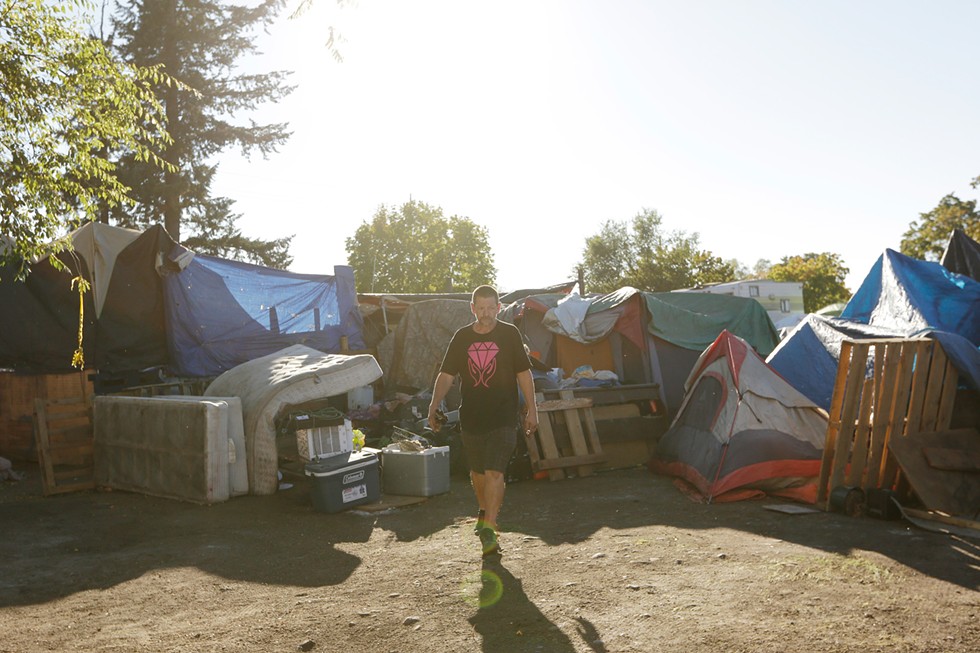
RIGHT-OF-WAYS
It's not uncommon for people to camp on right-of-ways owned by WSDOT. The freeway-adjacent parcels of land are generally isolated and tucked away, while still within walking distance of major urban centers. The most famous example is probably the Jungle, a former Seattle encampment on a stretch of land underneath I-5 that had an estimated 400 residents at its peak in the mid-2010s.
The Jungle, like Camp Hope, was a never-ending political conflict. Some people cited concerns with crime and called for it to be shut down as quickly as possible. Others argued that the people there needed more help: services, mental health support and desirable shelter options.
The tenor of the debate changed in early 2016, when a shooting at the Jungle killed two people and injured three. Facing mounting pressure, the city and WSDOT spent the next few months working to move the campers, eventually sweeping the whole thing in October 2016.
Ron Judd, WSDOT's external affairs director, says the sweep didn't go well. Tensions were high, and people wanted it done quickly. Without sufficient housing options, he says, most of the camp's residents just ended up scattered to other right-of-ways across the city.
"All sweeps do is rearrange where people are staying," Judd says. "It doesn't get them in housing, it doesn't provide them the services they need."
Judd says WSDOT learned its lesson and has since moved away from the sweep approach to encampment removals. In response to a significant, pandemic-related increase in the number of people living on spots near freeways, earlier this year Gov. Jay Inslee signed the "Rights-of-Way Initiative," which allocates more than $143 million toward moving people away from highway encampments and into safer housing opportunities.
The goal of the initiative isn't just to clear encampments. The state's goal is to work with local jurisdictions to identify better housing options and connect unhoused people with services that help them. The initiative, which is still in its pilot phase, identified five counties for assistance: King, Pierce, Snohomish, Thurston and Spokane.
The state first began engaging with Spokane leaders in May. By late July, money started flowing in to fund housing projects where Camp Hope residents could eventually be moved. The biggest project underway is the Catalyst Project, which, despite fierce opposition from its West Hills neighbors, aims to bring more than 100 units of supportive housing online in December.
Over the summer, as the city and state worked to identify where the money should go, Camp Hope continued to grow. So did tensions, as neighbors and businesses increasingly frustrated with crime attributed to the camp began calling for a quick removal.
In July, a heat wave sent temperatures soaring to 104 degrees, and Jewels Helping Hands built a large, unauthorized cooling shelter to protect the camp's residents from the sweltering heat.
The city, in a move that was criticized as inhumane, ordered WSDOT to take it down.
"The politicians at the city think because we aren't paying property tax, rent, water, sewage, garbage ... cable, and landline and all that — that we deserve to sit out here and die," Karen Potter, a Camp Hope resident, said at the time.
WSDOT refused to take the shelter down. The tent stayed up.
"Ultimately, the safety and well-being of people is our paramount concern," the agency said in a fiery statement that hinted at the growing rift between the city and state.
THE CAMPERS
The 450 people living at Camp Hope come from a variety of backgrounds. Some lived indoors recently, others have spent nearly their entire lives living outside. Some campers, Garcia says, grew up with parents who never lived in houses either.
Many are veterans. Gary, a camp resident who asked that his last name not be included, says trauma from his military service makes it difficult for him to stay in shelters.
Many of the campers also have mental illnesses that make it difficult to stay housed and employed.
"The politicians at the city think because we aren't paying property tax, rent, water, sewage, garbage ... cable, and landline and all that — that we deserve to sit out here and die."
tweet this
Some residents are addicted to drugs. Not every camper, as Knezovich has suggested, but there is substance use in the camp. Robert Moody, who used to live at Camp Hope and now works there as a security guard, says he regularly snatches foils (used for smoking heroin, mainly) while doing his rounds. Organizers say the camp used to be targeted by drug dealers who didn't live there, but who knew they could blend in with the residents. A security fence that WSDOT installed around the camp has helped stop that, they say.
Many campers have physical disabilities. Potter, who still lives at the camp with her husband and two dogs, has Type II diabetes. In late October, Jewels Helping Hands and Disability Rights Washington filed a federal lawsuit seeking an injunction against the city and county's plan to sweep the camp. The sweep, the lawsuit says, will "lead to people with disabilities being displaced, traumatized and criminalized disproportionately."
Many of the campers have pets. Mostly dogs, but there are a fair amount of cats, too, that run around the camp causing mischief and being cute. Gary, the veteran, has two dogs: Scout and Pretty Mamas.
Some campers have criminal records or eviction histories that preclude housing.
The campers, many of whom have lived at Camp Hope for almost 10 months now, are like a family, says Earl Anderson, who has lived at the camp for about three months. There's bickering and arguments, but there's also joy and community. He says that there have been issues with theft inside the camp, along with tensions between the east and west side of the camp, but that most residents are still able to come together and put aside their differences.
Chris Senn, a military veteran and one of three camp residents named as plaintiffs in Jewels' lawsuit to protect the camp, came to Camp Hope seven months ago. He didn't know anybody but says people still stepped in to help him out and share what little they had. Within the first night, he says, other campers made sure he had a place to stay, warm clothes and food to eat.
"Everybody here, for the most part, will give you the nothing that they have to make sure you have something," Senn says.
"A LINE IN THE SAND"
In September, the state began contracting with the Empire Health Foundation to do outreach work at Camp Hope. A lot of changes began happening quickly. Along with the perimeter fence, the organizers instituted a new nighttime curfew, floodlights, a badging check in-check out system and a list of rules campers have to sign off on if they want to stay. WSDOT hired a private security company to patrol the perimeter. The Empire Health Foundation, with $3.5 million from the state Commerce Department, began serving as the primary service provider at the camp, and is now subcontracting with local organizations to do additional outreach.
"What you see here is completely different than what it was about six months ago," says Zeke Smith, president of the Empire Health Foundation. "It's a much more organized and stable environment."
The state Department of Licensing is now there on a regular basis to do ID replacement. The state Department of Health, as well as the Department of Social and Human Services, also makes regular visits.
The work being done at Camp Hope hasn't stopped tensions between the city and state from escalating. In early September, the city threatened to declare the camp a nuisance property and ordered the state to take it down by mid-November. The state responded with a scathing letter accusing the city of shifting blame for a problem it created and being unwilling to work with the state to identify housing options that would lead to a humane camp closure.
"Acting on the city's ill-considered demand solves nothing for anyone," the letter said.
Knezovich saw the city's order as a "call to action." After the state said they wouldn't be complying with the order, the sheriff abruptly inserted himself into the fray, declaring his intention to sweep the camp by mid-October. He later moved the deadline back to mid-November at the request of Mayor Nadine Woodward, who likes to refer to the camp as the "WSDOT encampment."
"This is a drug-fueled protest of people who want no barriers, and they want to do whatever they want," Knezovich said. "This protest is about to end."
During this time, the state was in regular operational meetings with city officials. With threats of lawsuits and sweeps looming, the meetings got heated. Mike Gribner, WSDOT's Eastern Region administrator, says elected officials were asked not to attend some meetings, and those meetings were slightly more productive. Still, little progress was made. The state is still communicating with the city and county regularly, but Kelleher, from the Commerce Department, says the lawsuit threats have stifled any ability to have productive conversations.
On Oct. 25, the county declared an emergency at the sheriff's request, putting the pieces in place for a plan that would see the camp disbanded by Nov. 15. At a press conference, the mayor, sheriff, police chief and county commissioners detailed their plan to expand the bed capacity at the Trent shelter and convert it into a "navigation center."
"What you see here is completely different than what it was about six months ago. It's a much more organized and stable environment."
tweet this
The East Spokane Business Association has also thrown its support behind the city and county's plan. During an Oct. 28 press conference, neighborhood business leaders gathered to share stories of how the crime they associate with the camp has impacted their business over the past year. Jesse Smith, who manages the Fred Meyer near the camp, described drug deals and prostitution in the parking lot, assaults on customers and employees, feces and drug use in the store bathroom, and an unprecedented level of shoplifting. Other business owners had similar stories and called for the camp to be closed before Thanksgiving.
The increase in crime near the camp they describe is backed up by police department data, which shows a 114 percent increase in property crime within a quarter-mile radius of the camp compared to previous years. Ryan Overton, communications manager for WSDOT's Eastern Region, argues that the fence and other security measures put in place last month will help address some of the concerns about crime. He also notes that it's impossible to tell how much of the crime is coming from people who actually live inside the camp.
Two separate plans have emerged that will determine the future of the encampment. One calls for a slow, methodical process through which camp residents would be connected to shelter options that match their needs. The other argues that the camp has gone on long enough and that the city's current shelter system has adequate capacity to absorb the camp's residents. Here's a who's who behind each approach.
SLOW AND STEADY
Washington State Department of Transportation
WSDOT owns the land occupied by Camp Hope and is coordinating with other state agencies to slowly clear the camp and connect residents to services as part of the state's "Rights-of-Way Initiative."
Washington Department of Commerce
As part of the state's initiative, the state Commerce Department has made $24 million available to move the camp residents into more permanent housing in Spokane.
Empire Health Foundation
The private health foundation has been tapped by the state to coordinate outreach work at Camp Hope.
Jewels Helping Hands
Led by Julie Garcia, the nonprofit has been the driving force behind Camp Hope since the camp's inception. It's now being subcontracted by the Empire Health Foundation to manage the camp. The Empire Health Foundation is also subcontracting with Revive, Compassionate Addiction Treatment and the Spokane Low Income Housing Consortium.
The campers
Close to 700 people lived at Camp Hope during the summer, but the total number is now closer to 450. Many campers say they prefer living at Camp Hope over one of the city's shelters.
FAST REMOVAL
The Sheriff
Spokane County Sheriff Ozzie Knezovich has been a fierce critic of Camp Hope and is leading the charge to sweep it by the end of the month.
Spokane County Commission
On Oct. 25, the county commissioners passed an emergency proclamation at the sheriff's request allowing leaders to bypass a competitive bidding process while preparing to clear the camp.
The Mayor
Spokane Mayor Nadine Woodward is standing behind efforts to clear the camp and proposing a plan that would see the Trent shelter expanded and campers moved out of Camp Hope this month.
The Police Chief
Spokane Police Chief Craig Meidl has associated the camp with an increase in neighborhood crime and joined the mayor in calling for it to be cleared this month.
East Spokane Business Association
The group of businesses near Camp Hope has complained about heightened security and property crime issues and called on the city to clear the camp by Thanksgiving.
NAVIGATION CENTER
The state is skeptical of the city and county's plan, and state officials don't think the Trent shelter will be able to accommodate all of Camp Hope's residents. Even if there were space, they argue that most campers would refuse to go. Trent is a congregate shelter, with hundreds of beds all in the same room. Garcia says some camp residents might be more willing to go now that the Salvation Army is operating the shelter, but most will still choose not to. (The city ended its contract with the previous operator, the Guardians Foundation, after a fraud scandal last month.)
Kelleher, from the Commerce Department, has previously worked with three different navigation centers in other parts of the state. He notes that "navigation center," like many phrases in the homeless services world, is a bit of a buzzword that means different things depending on whom you ask. In general, the phrase refers to a temporary place where unhoused people can stay while working with various service providers to get connected to more stable housing.
Progressives like Spokane City Council President Breean Beggs say the outreach work being done at Camp Hope falls under the definition of "navigation center," and he questions the city and county's plan to shut down Camp Hope and stand up a new navigation center at the Trent shelter.
"My sense is we don't have the money for a second one, and it's very disruptive to forcibly move everyone over there," Beggs says. "The Trent shelter is not big enough to do it."
Still, the sheriff wants the state to "come to the table" and work with the city and county on their emergency operations plan. The state says they won't do that.
"If you want to work with us, lift the lawsuit and we'll talk," says Gribner, from WSDOT.
The money supporting the outreach work at Camp Hope is tied to Inslee and the Legislature's initiative, which has very specific criteria, Gribner says. If WSDOT and the other agencies got on board with the city's plan and tried to sweep the camp, the money would disappear.
To be clear: The state isn't opposed to the Trent shelter as a concept. It's a good option for some residents, and Gribner says Camp Hope residents are regularly offered rides to the shelter if they want to go there. But congregate shelters don't fit the needs of everyone at the camp.
"Throwing them all in a congregate shelter assumes everybody is the same," Gribner says. "Nobody here is the same. No story is the same. It's a recipe for failure."
Speaking in Seattle last week, Gov. Inslee touted the success of the "Rights-of-Way Initiative." Most of the encampment removals conducted under the initiative have been in King County — a fact that Overton, from WSDOT, attributes to strong cooperation between local leaders and a diverse housing supply.
When asked about Camp Hope, Inslee said the state is taking an "assertive, aggressive approach" to find additional housing opportunities for the camp's residents and that the state wants to see the camp moved "as soon as humanly possible."
If local authorities ultimately try to clear Camp Hope this month, Gribner says there's not much his agency can do to stop them.
"We're not going to lay in front of the sheriff's car," Gribner says.
Still, he's skeptical of the city's drive to actually follow through on the deadline, and he says he'll be curious to see how things change after this week's election.
HEADS DOWN
WSDOT is preparing for the coming winter by putting up warming tents with propane heat in the middle of Camp Hope. Despite the city and county's ongoing plans with the emergency operations center, Kelleher says state officials are keeping their heads down and moving forward with the work.
Still, the looming threat is making things difficult. Vincello, with the Empire Health Foundation, says the constantly shifting deadlines are making camp residents nervous and interrupting the outreach work.
Sharyl Brown, a peer navigator with Jewels Helping Hands, says she worries about the prospect of a sweep but tries to block it all out when she's doing work on the ground at the camp.
"What they're doing is distracting us from what we're doing," Brown says. "I'm not going to allow that."
Brown used to be homeless. That experience helps her relate to what camp residents are going through and builds trust as she helps them work through the byzantine process of applying for housing and other services. The work has been going well, she says. The camp is shrinking, and organizers say more than 100 people have moved out and into better housing options.
Even with everyone gathered in the same place, Brown says she still has frequent trouble locating residents and helping them get to appointments on time. If the camp is cleared, she worries they'll be scattered across the city and she won't be able to find them.
"It would ruin everything," Brown says. ♦

